
Condor
-
Posts
435 -
Joined
-
Last visited
Content Type
Forums
Detector Prospector Home
Detector Database
Downloads
Posts posted by Condor
-
-
My prospecting buddy in San Diego and I decided to take a run down to Baja to see if this summer's hurricane event had moved any gold around. This particular Baja placer has been pretty popular over the past 20 years and we've pretty much hunted out all the easy stuff so we had high hopes for a new bonanza.
We left on Monday crossing the border at Calexico. I was waved through after a cursory examination by the Mexican border officials. My friend was in a different lane and he was subjected to a much more thorough examination. I think it was end of shift and the border officials needed to make some quick money. Four of them pulling everything out of his truck. They ultimately came to his 7000 detector. He explained its use and then they asked what it was worth. He lied and told them $4000.00. They saw dollar signs because according to them he would need to pay an import duty on the equipment, $420.00 US dollars cash. I guess 100 bucks apiece is a good nights work. He refused and told them that he would just return to the US. After that the price came down to $240.00. He still refused and we used the turnaround lane back to the US side of the border. It's hard to argue their notion of justice.
We spent the night at my house in sunny Yuma and decided to cross at Algodones the next morning. That crossing was going well as far as inspection, but then the immigration officer inquired as to our Mexican Visas. We've never needed a Visa in Baja unless crossing the states of Baja Norte to Baja Sur. So, we bought some much needed $35.00 cash only Visas and continued on our way.
The summer hurricane wiped out most of the paved highway just outside of San Felipe. They were working on replacing the highway but in the meantime you're restricted to a rough one lane dirt road over about 40 miles. From my house to the Placer is abut 240 miles and we arrived in the early afternoon. The prime ground is another 3 miles by ATV. We spent the rest of the afternoon building some ramps and filling big holes to run the my Rokon and his Yamaha Big Wheel up the canyon. The hurricane had run water about 20 ft high through the canyon so all our improvements from last year were washed away. It was tough sledding all the way but I didn't get unhorsed this year. My friend took a nasty fall after his bike slid down a too smooth rock wall. He was hobbled and we ended up cutting our trip short.
Nevertheless, I got one good day of detecting in. I found a stretch of bedrock that last year had a foot of overburden on it. It was now swept clean and I found these small nuggets in bedrock cracks. I intended to check some promising ground about a 2 mile hike away, but I just couldn't justify leaving gold to find gold. Maybe next trip.
The weather was great and the gold available, just not enough time after our border mishap and my friend's banged up knee.
-
And sometimes it's just a seam of hotrock. This started as the sweetest sounding target signal all day. Faint rising tone, kept getting better and better the deeper I dug. I turned down the sensitivity and kept digging expecting the signal to overload the tone any minute. Then it stopped getting better and got weaker. I scanned over the pile and got garbled tones all over the pile. I walked back to my truck and got out the Nox 800 with 6" coil. Back down the mountain and scanned the hole and piles. Nothing but -9 tones everywhere. Past performance is no guarantee of future performance.
-
I know you guys want to keep your trade secrets, but can you shed a little light on the effects of your "filters". I've read elsewhere that in retrospect your choice of the term filters was probably misplaced. We'll stick to the same terms so as not to confuse people.
I've been running your enhancer for about 12 hrs total and have experimented with the settings some. My particular choice in running the Z machine has always been with absolute minimum threshold and low smoothing with as much Sensitivity as I can get away with. Rarely if ever do I use Difficult because it has proven time and again to miss small deep targets in the relatively mild ground of the Desert Southwest of Arizona.
I started out with your enhancer on "filter" 2 which seemed to be a nice "bright" kind of tone, but the more I struggle with hot rocks and variable hot ground I've taken to "filter" 3. Filter 3 as first seems to have an overall dulling effect to the entire sound spectrum, but I'm starting to think it rounds off the high tones enough to extend my detecting time from hearing/sensory overload. Maybe I could have reached to same goal by playing with the Z tone control, I just haven't taken the time to experiment more. As always, individual hearing is all subjective, and perhaps this is just an unintended affect on my hearing and is meaningless to other people.
Can you share a little more of your theory of how these enhancers were intended to work, whether or not you achieved that goal.
-
I got out for a few hours this morning with the Z hooked up to the sPo1 enhancer wired to the WM12 for wireless operation. I spent the first part of the morning rolling big chunks of granite that were giving off faint positive tones hoping that one of the tones would continue once the rock was moved. I was having no luck other than shards of lead bullets. I stepped up on a bench section of an old desert wash and saw that someone had dug a Z coil sized hole about 4 inches down. I waved over the hole and got a faint positive tone, not much different than the 30 or so I had experienced from the granite rocks on the way down the wash. I hit a couple big chunks of granite with the pick and pulled them out of the way. The faint tone was still there, but seemed very broad and not well defined. I dug down another 4 or 5 inches and waved the coil over the hole, still a faint, broad tone not much improved. Thinking it was more hot granite I switched to Difficult. Nothing, not a peep. I was about to give it up as another hot rock but decided to dig a few more inches. Now I'm down 8 or 9 inches and the tone improves in volume, but still seems overly broad. I dug down another 4 or 5 inches and the tone is really crazy. No clear location and it started sounding like crumpled foil with a choppy broken tone. Now I have to widen the hole and go down another few inches. The Z tone is really crazy so I switch to Difficult. Even Difficult is catching the tone now, but it's sounding like a piece of wire. I'm pretty sure I'm down past the trash level and start scooping out the hole with my plastic scoop. As I'm scooping it out I see a layer of rusty red, crumbling clay rock. This stuff is fairly common down here and it's hot enough to really gives the Z machine fits. I get out the pinpointer and stick it down in the hole. The pinpointer goes crazy over the entire hole. I scoop out some of the red stuff and wave the pinpointer over it. It goes crazy, so I wave the scoop over the Z coil, it reacts but not overly so. I'm about to give up for the 3rd time, but I decided to dig out all the red stuff and take some home to pan out. I've had trouble with the Z over this red stuff in the past, but never this deep and Difficult usually cleans it up. Now I'm digging in earnest and using my pocket knife to carve this stuff out of the wall of the hole. I get another scoop of it and wave it over the coil, nothing this time. I am baffled so I stick the Z back down there and bam this thing is sounding like a fist sized chunk of foil. I take the Sens all the way down to 1 and stick it back in the hole, still banging like a gong. I get the scoop and start scraping everything else out down to this red clay layer. I'm piling it away from the hole to try and separate the sounds. As I pick up the Z to check the hole again, it sounds off over the pile. I got you this time you little bugger. I"m thinking it must be a 1/2 oz craggy specimen, see for yourself.
I measured the hole off on the handle of my pick. Right at 19.5 inches deep. That's not including the 4 inches the first guy dug and left it thinking it was a hot rock. That's awfully deep for 2.4 grams, even for the Z machine. I'm thinking that hot red clay somehow magnified and distorted the signal. I've dug plenty of deep gold with this machine, but nothing like that.
I'd like to say the steelPHASE enhancer did the trick, but that would probably be a stretch. This was just an oddball situation with a crazy sounding nugget. I did recheck the hole and my piles, there was still some reactivity in some of that crumbling red stuff, but not enough to convince me it was golden. I was running the Z machine in HY/Normal/ Sens 16/0 Threshold/Low Smoothing.
Beatup- This is the same washes your brother favors past the power lines at Sugarloaf peak. I wonder if he missed this one.
-
55 minutes ago, fredmason said:
Very patient testing, Steve...I can never seem to wait, so I just start digging...
Have you tried the Steelphase through/with the wireless module? I would not give up being wireless for hardly anything...
nice little nuggie
fred
Well Fred, you could still be wireless, just an added cable from the WM to the box then your choice of listening equipment plugged into the box. A bit of redundancy if you wanted to just rely on the simplicity of the WM. I don't think you can amplify the WM without wiring the box in between so now you're back to the old days of a cable between you and the detector. The unit comes with about 3ft of heavy duty audio cable, with double ended male, mono headphone connectors. I'm using a curly corded one that I had from past inventions. You couldn't do my set-up with the supplied cable unless you disconnect to lay the detector down and dig. The only reason I did it this way was to keep the fewest number of "connections" between me and the original detector signal. I will ultimately go with the wireless connection when I decide to do some serious detecting.
-
JW and Simon,
JP said something about the 7000 volume a long while back and its stuck in my head. He said something about increasing the volume had the effect of increasing the Sens. I can't remember of the whole context of that observation or its relevance today however; it occurs to me that in your quiet ground perhaps you could max out the 7000 volume then bring it under control with the volume level on the SP01. Perhaps you thereby maximize Steve's already Insanely Hot settings. Mental gymnastics I'm sure, but something to ponder. Wouldn't work here.
-
1 hour ago, beatup said:
Good information Steve keep em coming.I need all the helpfull info i can gather before i head down your way.
Yeah, I'll keep at it Brett.
Probably won't be any nuggets left by the time you get here. I'm going to attend Bill Southern's deal out at LSD this weekend. Maybe find some new prospecting ground out there. If Eric gets lonely down here, have him give me a call.
-
Bear in mind that hearing is highly subjective. My experiences will in no way be the same as anyone else's and I'm forced to use imprecise terms to describe my efforts. At 64 yrs old my hearing is relatively good and high frequency noise bothers me more than most. We all know that the Z7000 is a noisy machine but with time and experience our hearing adapts and we become more proficient with it's tendencies. So, after 3 or 4 months away from the machine it's like starting all over and wondering, wow this detector is really noisy. That's how it has been for me over the last couple days out here in Sunny Yuma. Add in some decent rain last month and certain rock types hold some moisture and became a major hot rock nuisance.
I hit a deep gully yesterday that had a lot of decomposing course grained granite. The granite is ordinarily pretty mild, but the left over moisture was making fist sized chunks into high spiking hot rocks. They're really not the kind of hot rocks that sound like nuggets, the tone is a short high pitch that falls off very quickly. Going to the Difficult setting really calms them down, but then you're missing small faint nuggets. Raising the coil and going painfully slow is one solution, as well as keeping detecting sessions short.
I decided to see if there was some kind of intermediate step with the SteelPHASE system of filters. After some trail and error I settled on Z7000 settings of High Yield, Normal, Sens 12, Low Smoothing, with just enough threshold to level off the spiking signals. Then I played with the SteelPHASE. I used the recommended Mode 1, then went through the various filter settings. Filter 1 and 2 give me a high "tinny" kind of tone over the hot rocks, not helpful. Filter 3 as best I can describe dulls all the tones, but was the best choice in this circumstance to dull the high tones of hot rocks. After a half hr I was cruising along pretty good partly because my hearing was adapting and the SteelPHASE was keeping the annoying hotrocks at a manageable level, or so I think.
I finally got over a very faint signal well into the side bank of the gully. I went through everything I could think of to test the equipment. First I left everything in place and switched to Difficult. Not a peep. Then with everything in place I raised and lowered the sensitivity. Sens below 9, the tone was barely audible and mainly because I knew it was already there. I doubt it would have stopped me otherwise given all the noise in hotrock heaven. Raised Sens really made it stand out, but the noise would have been unmanageable for normal prospecting. Then I unplugged from the SteelPHASE and plugged my earbuds directly into the Z. The tone was audible over the target and probably enough to stop me in normal prospecting mode. Back into the SteelPHASE for a comparison. As best I can tell the SteelPHASE gave me some "separation" from background noise and a bit of "distinction" or "amplification" of the actual target. By that time I had pulled all the surface hot rocks away, so I was no longer bombarded with that kind of noise. I switched back and forth a few times and found the SteelPHASE gave me a more noticeable tone, (I think).
I dug this tiny nugget out and was again amazed at what the Z7000 can do on small gold. This nugget was back into the side bank and down at least 6 inches. I think its round ball shape gives it a better density that favors detection at this depth.
So, with a 6 hrs use on the SteelPHASE in some very limited circumstances, I would say that it is helpful but not a game changer. Anything that boosts my confidence and keeps me in the field a bit longer will no doubt increase my odds. Perhaps for the guys who use external speakers and need an amplifier anyway, this is a good
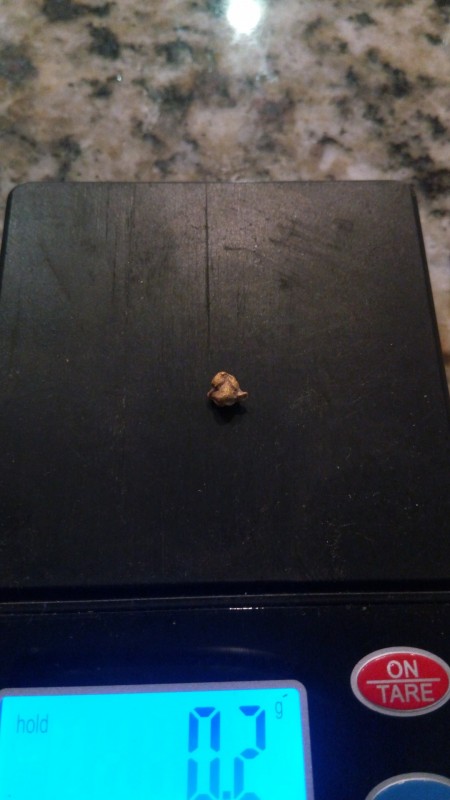 investment. I just don't use speakers so we'll have to wait for one of them to chime in. Given its $200.00 pricetag, I give it a neutral thumbs up/down for now. I'll keep at it, it's early yet and will report more as it happens.
investment. I just don't use speakers so we'll have to wait for one of them to chime in. Given its $200.00 pricetag, I give it a neutral thumbs up/down for now. I'll keep at it, it's early yet and will report more as it happens.
-
The weather is finally starting to break here in Sunny Yuma. Still hitting the high 80's but the mornings are decent. I got out for a few hrs this morning to try out the new SteelPhase signal enhancer. I picked one up from Rob at Rob's Detectors in Surprise, AZ. I'm a sucker for every new piece of equipment that might give me an edge on the other guys. I wired the SP01 directly to the Z7000 with my in-ear monitors (earbuds) plugged into the headphone jack of the unit, I didn't use the standard Minelab wireless module for this test. I can't say I wouldn't have found this nugget without the SteelPHASE but it didn't hurt. The signal was very faint in some pretty active ground. After I was fairly certain I had a faint signal I ran through the "filters" on the SP01. Position 3 really dulls all the tones, but the faint target signal was still pretty clear. Position 2 seemed to be the best. It was a long tedious dig getting through the interlocking rocks of a deep desert gully. At about 18 inches I was down to sensitivity level 1 on the detector and still having trouble with the tone overload. I got out my new and unused Minelab Pro-Find pinpointer (more toys) and bingo, pinpoint problems solved. The 2 nuggets were actually attached by a thin strand of gold but came apart when I tried to clean the dirt off. A good morning all in all. I have detected this gully at least half a dozen times, and I know that BeatUp has detected it at least as many times. I saw BeatUp's well covered and concealed dig holes so it has been a producer in the past.
Next time out I'll try and check targets with and without the SP01 to see what kind of difference there might exist.
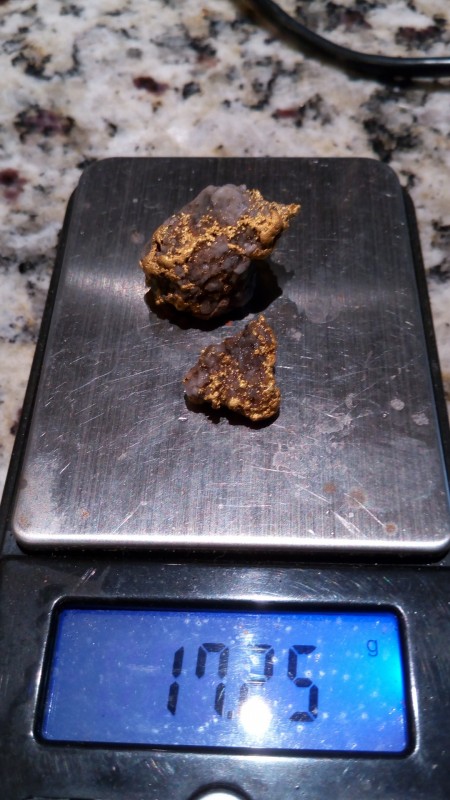
-
Based on my recent experience with micro placer gold, I have a question about Ground Balance. I know Steve has at various times, in previous posts, talked about ground balancing on Multi-Frequency machines, especially as it pertains to beach hunting. I did not realize until today that Park 2 is a fixed ground balance. I did not Ground Balance the machine at all in Park 2, but had used the manual ground balance in Gold 2 to start out, then expected the Tracking Ground Balance to take over. I presume the Manual Ground Balance I did in Gold 2 carried over to Park 2 because it certainly handled some fairly hot ground with no problem. However, I chased a few very faint targets and it seemed like the NOX was tracking them out. I dug out the areas where I first heard the faint targets that NOX subsequently tracked out, and most of them turned out to be pockets of hot grey clay. NOX was clearly doing its job and trying to ignore changing hot ground, but with a Fixed Ground Balance, it shouldn't have been able to do that.
Perhaps it can be attributed to the PFM(pure f-ing magic) of Minelab's Multi filters, but if it's more easily explained inquiring minds would like to know.

-
19 minutes ago, Steve Herschbach said:
Thanks for the follow up report Steve. I saw enough this year to change my "in use machine" list on my profile to just GPZ 7000 and Equinox. Between those two detectors I can do 98% of what I want to do with a detector.
I am holding on the my White's V3i to run my Bigfoot coil, but the fact is I have not fired it up once this year. It's strictly a large field jewelry sweeping device for me, nothing more, and I have not done any of that this year. So far. I have a Gold Monster, Gold Racer, Gold Kruzer, and Goldmaster 24K also, but all of them essentially tiny gold machines. And for that right now I am going to grab the Equinox with 6" coil first, just because of the tricks like you are playing now. I absolutely know what the other machines will/can do, but Equinox and Multi-IQ simply has surprises, good ones, and that's fun for me at least. It's fun figuring something out that is genuinely new.
Seem to me you were not thrilled by the Deus Gold Field mode either, preferring to use a modified disc mode instead. All metal can get oppressive in really noisy locations.
The bottom limit for "tiny" on the Equinox must be darn near microscopic.
I'm still baffled on how this Park 2 filters the hot rocks and hot ground so much better than Gold 2. I believe this machine could be set up for a rank amateur, wife, girlfriend, kid who want to try detector prospecting but will burn out quick if they spend too much time chasing hot rocks and hot ground. Set this thing in Park 2, Sens 20 and dig anything that gives a high tone and a VID under +12. All my bigger test nuggets come in at +8 to +10.
-
13 minutes ago, phrunt said:
Thanks, now I want to take my 6" out for a spin and try out your tactics, I've probably passed up on a fair bit of small gold..
You will not be disappointed with this tactic if you have small surface gold. The machine runs dead quiet till you get over a target. The deepest target I dug was the biggest of these tiny nuggets, down maybe 2 inches. The key is a high tone chirp. I will try and get the Z 7000 over a decent undug target and check it with the NOX.
-
I got back out for a couple hrs this morning and verified my NOX 800 settings. I was definitely running with no discrimination in Park 2, with Sens at 23, running in the 5 tone mode. I toggled back and forth on a couple targets with the Gold 2 setting. Park 2 was way better at, for lack of a better term, separation. The Gold 2 audio was really overloaded with the background of "hot rocks/ground noise". The VID in Gold 2 stayed at -8, -9, clear hot rock reading and the target response was very broad. I tried to add some discrimination in Gold 2 to see if I could tame it down. No go. Whereas the Park 2 gave a crisp zip type signal over the target. The VID on undug targets in Park 2 varied from 0 to -5. Once the targets were in the scoop they ranged from 0 to +2. Park 2 eliminated well over 90% of the "hot rock" tones that were killing me in Gold 2.
Again, the key was the positive high tone even if it was combined with the low tone growl. Many of these undug targets only gave a high tone in one direction. Once they were uncovered they were generally positive high tone in all directions. Forget about the VID for these tiny pieces of gold.
I doubt many prospectors expect to pursue a steady diet of these tiny mico gold nuggets, but it's good to know the NOX can certainly do it. I figure the larger gold with take care of itself, I just need to get the coil over some. We've absolutely hammered this little spot with the Z7000, so most of the bigger gold is already in the poke somewhere.
The NOX 6" coil absolutely rocks on tiny gold!
-
Now I have to go back out tomorrow and re-check my settings. I'll take along the rake and pull down some of the piles for good measure.
-
I "horseshoed" out for no discrimination, yet the machine silenced the hot rocks. My assumption is the Iron Bias accounted for that, but that's a guess.
-
Holy Cow Rick,
You are the god of Rye Patch. Bravo Zulu as always.
-
Temps here in Sunny Yuma are still unbearable, but I got out for a few hrs early this AM to play with the Equinox 800 and 6" coil. I went back to the same spot as last week, an area of relatively flat drywash tailings. I poked around for half Hr in the Gold II setting but the hot rocks were becoming quite tedious. Even if you apply some discrimination, they blow through the filter with a choppy broken tone. I remembered that our skilled Moderator has said, many months ago, that he was quite confident in finding small gold in the Park II mode. I thought I'd give it a try figuring the hot rocks would come in the low tone and gold would pop through in the higher tones. I picked a spot of choppy hot ground and put down my 1/4 gram test nugget. It zipped through with a nice high tone and the choppy hot ground more or less disappeared. I ran the Sens up to 23, no discrimination, everything else factory preset in Park II. It was truly amazing, the hot rock tones were gone. Park II also runs with no threshold so the machine was nearly dead silent. I went back over the ground I had just covered and started popping these tiny bits of gold. Half of them came out of boot scrapes I had left last week. I did not rely on the VID numbers, just the tone. If the machine grunted a low tone but fluttered a high tone I dug. I pulled up some tiny pieces of rusted steel and wire, but enough of those targets turned into gold to keep me digging. I watched the VID numbers on a couple targets. They started out negative VID -7, -8, but when uncovered popped 0 or +1, all the while with a high tone.
As we discussed on the last thread, VID numbers for gold vary, but now it's clear that relying on VID is going to miss gold. The tones were certainly more reliable than VID in this situation. And clearly, Park II is plenty sensitive to small gold. These 10 pieces combined would not register on my scale. I used a sewing needle for scale, they are that tiny.
I suspect that the hot rocks were screened out by the "iron bias" filter, perhaps Steve can shed more light on that aspect. This machine is really starting to impress me.
-
I tested the 11" coil last winter with some test nuggets and a couple undug targets I located with the Z7000. They were in the .5 gram range and rang up consistently in the +8 to +10 range. As you may recall the bump sensitivity of the 11" drove me batsh__t crazy so I really didn't use it much after that. I did test a .5 grammer this morning with the 6" coil. I laid it on some fairly hot ground, but still was not much more than an air test. It screamed loud and clear, consistently showing +8 VID at about 6" above the target. I should be able to get out for a couple hrs over the next few days. I'll try to find a good target with the Z then follow up with the NOX.
-
Many thanks to forum member Rege in PA (Minelab Dealer) for holding the Equinox 6" coil for me. I was in and out of cell coverage for over a month and Rege held the coil for me despite having numerous other buyers making inquiries.
Anyway, it's still too hot here in Sunny Yuma for any serious detecting so I took the NOX and little coil out for some early morning practice. At sunup it was 79 degrees, heating up to 105 in short order. I decided to hit some old drywash tailings piles that are easy to reach, moderately flat with no brush cover at all. The ground is relatively mild, with some hot areas of red clay and alkaline grey volcanic ash down deep. After playing with the settings a bit, I settled on Gold II, factory presets then added a little threshold up to 10 and sensitivity at 23, running with no discrimination. I used my usual corded in-ear monitors(earbuds) plugged directly to the machine. That much sensitivity is a little too hot, but I just slowed way down which suited my body in these temps. I dug everything that gave a threshold flutter just to see what the NOX was capable of. I hadn't gone 10 minutes when the first truly sharp signal and a positive VID number, ranging from +2 to +4 came through. I scrapped off the top layer of loose gravel maybe an inch worth and had the signal in the red clay. Luckily I had my cheater reading glasses and a good plastic scoop because this nugget is supremely tiny. I found the second one nearby, again a consistent positive VID number at +4. If I hadn't had my glasses, there is no way I would have believed those bits were gold. I dug a number of other - (minus) VID targets just to make sure the NOX VID wasn't getting fooled. Hot rocks were a consistent -8, -9. Tiny scraps of metal sometimes reached +1, but no higher. I had one screaming positive target that turned out to be about .5 gram of lead bullet fragment down about 4 inches. The VID on that ranged +7 to +10.
The coil was pretty stable given those conditions with flat ground and no brush with little to no falsing.
My standard detector is the Z7000, but I have off and on over the years used VLF including Gold Bug II, Gold Bug and quite a bit of the Deus with the High Freq coil. I am truly amazed at the capability of this NOX. Under my conditions today, it would lose nothing to a Gold Bug II.
Minelab Equinox Rocks!
-
55 minutes ago, Ridge Runner said:
Condor
I had one sometime back and I ran it with both wheels on the ground. With that engine you may want to add wings.
Remember it’s not the fall that kills you it’s that sudden stop.
Chuck
I generally fill that front wheel tank with water to keep from catching air on steep climbs. That extra 40 lbs out front really helps keep her on the ground. The gearing is so low that even if you had 25hp your top end wouldn't change much. I've been doing the break-in on the irrigation canal roads around my house. The low end acceleration and torque are really improved. I'm looking forward to be back out in the hills.
-
After my Rye Patch ordeal, I decided to splurge and put a new engine in the Rokon. The original Honda 5.5hp 160cc engine is 20 yrs old and my hop up mods were really pushing it too hard, so I bought a lightly modified Honda Go-Kart racing engine from NR Racing. $500.00 gets a new Honda 6.5 hp 200cc engine with mods that bring it up to 12hp. All the bolt patterns are the same so it slipped right in the Rokon frame. I had to do a little drilling and bending to make a new throttle linkage and now she purrs like a kitten. I'll be headed back up to CA gold country next week and ultimately back out to Rye Patch. The goldfields are calling, Tally Ho!
-
I ran 2 Ozt of my -50 mesh, black sand concentrate through the Blue Bowl. It came out to .5 gram. This was 2 oz dry concentrate off the top of the container, I suspect the bottom my be richer after all the jarring around for the past 2 weeks. I'll send the Blue Bowl tailings and about a couple lbs of concentrates to Rege in PA to see what his Miller Table can do. If I could fill the back of my truck with this stuff it might be worth something, but as it stands not really a game changer.
Still waiting on Rokon parts, then back to Gold Country. I've got a new plan, of course. 118 degrees here in Sunny Yuma tomorrow, but it's a dry heat. Yeah great!
-
16 minutes ago, Rege-PA said:
Wow Steve! Looks like a good time on the river. I would like to try to liberate some of that concentrate on my Miller table. It could be the ticket to getting the gold out.
We`ll talk later......
No problem Rege,
I'd love to see what happens on the Miller Table. Give me a call with the physical mailing address. I might have the address for the Archery Shop.
-
Part III
Gold
As it turns out there is tiny -100 mesh gold just about anywhere you stick the shovel. In any pan you're likely to see 3 or 4 tiny specs of gold and a lot of black sand. The problem is as old as time, find a concentration and figure out a way to recover it. What I discovered on the gravel bar was a thin flood layer about 4 inches thick under about 8 inches of overburden. The layer was distinct because it contained mostly sharp cornered gravel rather than typical rounded river gravel and it contained a lot of mud/silt/clay binding the layer together. Once you get a decent hole started you can chase the layer, pushing the overburden in behind you. A typical pan of this material is likely to contain 30 to 50 colors, mostly -100 all the way down to -400. I had a pocket magnifier and looked at this stuff under 100x magnification. It's incredible, but you really have to get a lot of it to have any real weight. It really looks impressive when you have to black sand to highlight it, but when you pan off the black sand this stuff will float right out of the pan.
I had reconfigured my Gold Cube to be more of stacked sluice, capable of handling 1/4 inch material. I added Deep V black matting to the top tray, one of the new esoteric "catch it all miracle" mats to the second tray and Deep V in the 3rd tray. The top tray was catching 90 percent of the gold, so I only cleaned the bottom trays at the end of the day. I would dig 2 buckets (4 half buckets for carrying ease) classified down to 1/4 inch then run it through the Cube. Photo 1 is what typically I would get out of 2 buckets. I would pan it down to the black sand and if there were any pickers I take them out and dump the concentrates into another bucket for later processing. After a couple days it was clear that this type of gold production wasn't going to change my lifestyle much. The most I ever ran was 10 buckets. After a few days I panned off the +50 mesh gold for 2.87 grams. Clearly I wasn't going to get rich on this project. But, it was better than being home in Yuma at 118 degrees. My girlfriend would occasionally get energetic and help shake the bucket classifier, but she was satisfied sitting in the shade reading. I figure I was getting about 1 gram of gold per day, working a couple hrs, then swimming, fishing etc. A more dedicated person with a sluice tuned for beach type gold could obviously do much better.
After she left, I started exploring and sampling in more remote areas. A lot of hiking and the best I found was an area with all this riverside sedge grass growing right on the bedrock. It involved a rigorous hike on a very narrow trail overgrown with poison oak. I stuck to panning because I didn't want to haul much equipment in there. An unbalanced pack on that steep trail might have been disastrous. The roots of this sedge were like natural miner's moss. They were so tough I chopped them with a hatchet them shredded them up in a bucket of water. It might take an hr to get 1/4 bucket of this material, but it was so rich in fine gold. In photo #2 is the gold I took out of one pan from a crack under the sedge roots. Unfortunately, there just weren't many of those. The weather had turned really hot, so I would sit on a ledge waist deep in the water and pan out my 1/4 bucket. Again, I would pan down to the black sands then save it in a concentrate bucket. After I got tired of panning I would have to waste time until the sun set enough for the long hike back to my Rokon.
Again, if I had been serious with the right equipment, I could probably get 3 or 4 grams a day until I ran out of sedge grass.
So, after 3 weeks I decided to go get some big gold at Rye Patch, and we know how that turned out.

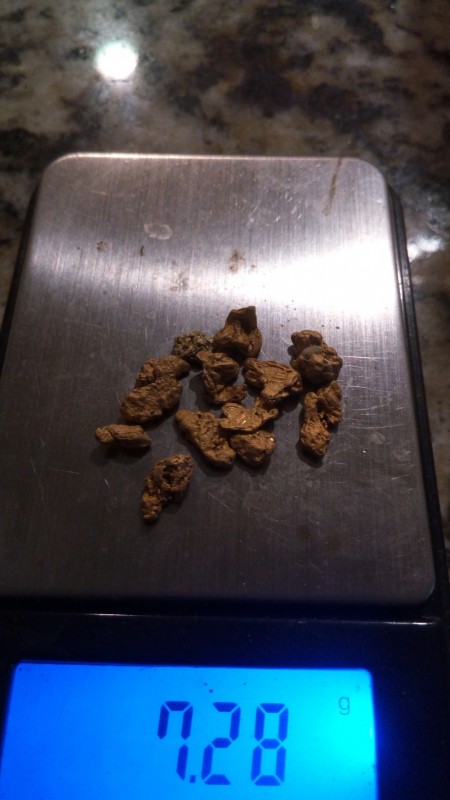
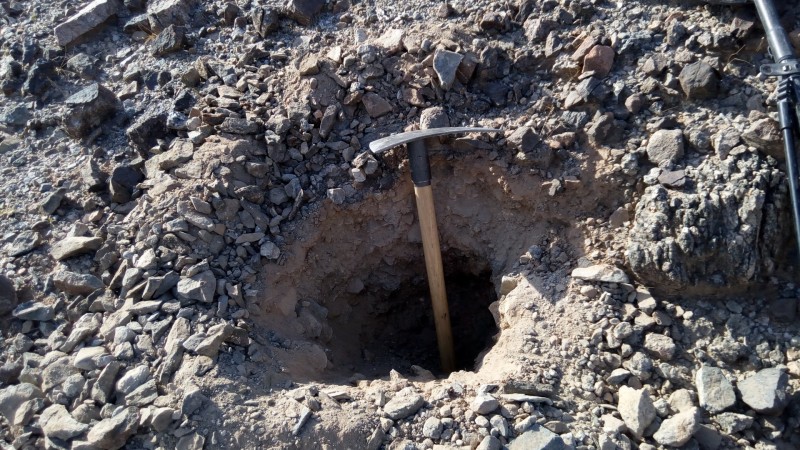
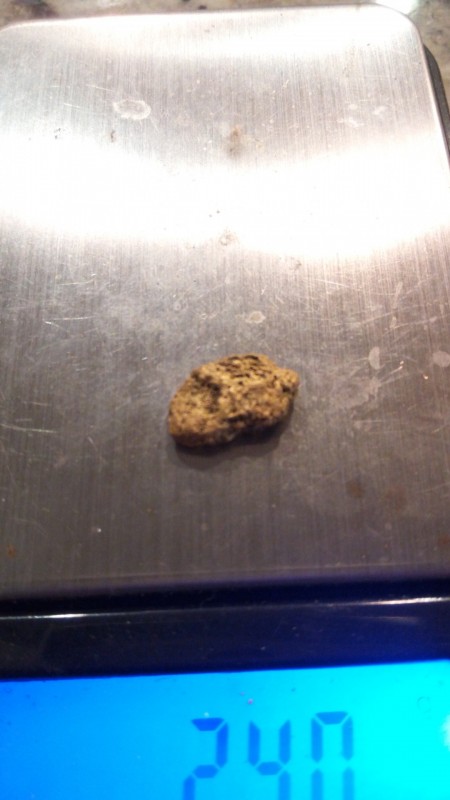
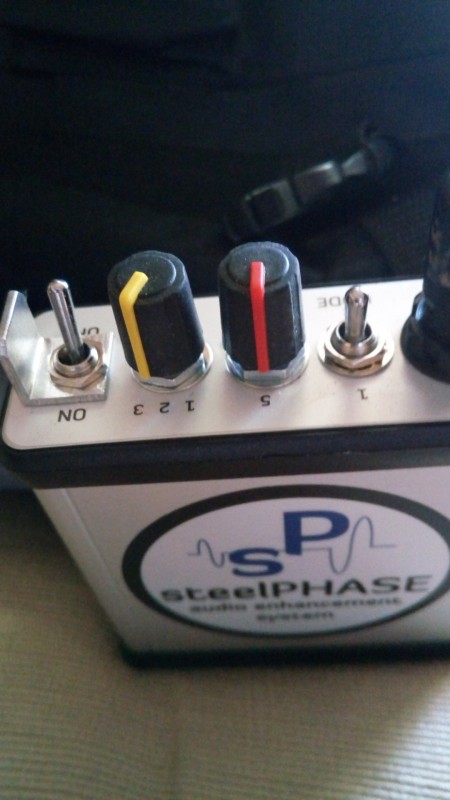
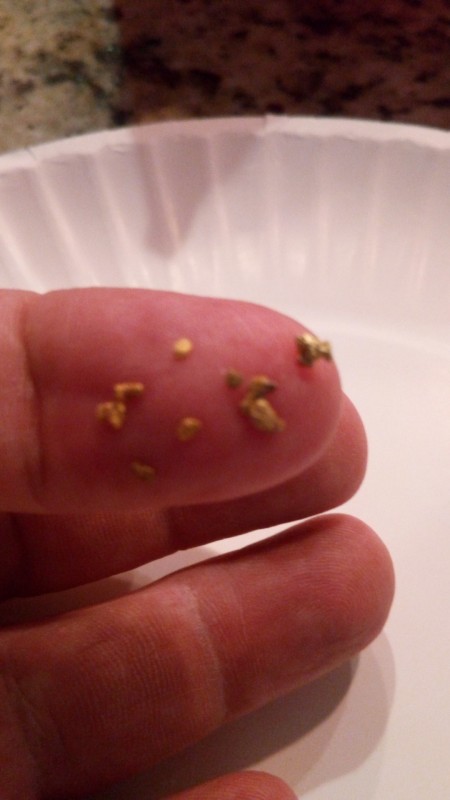
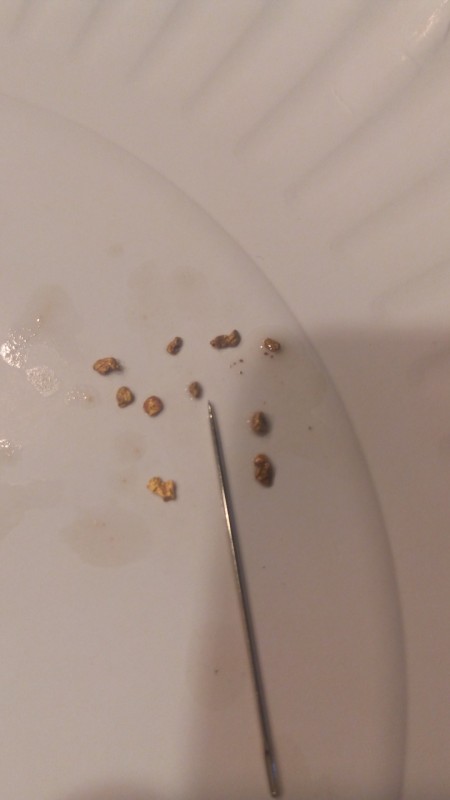
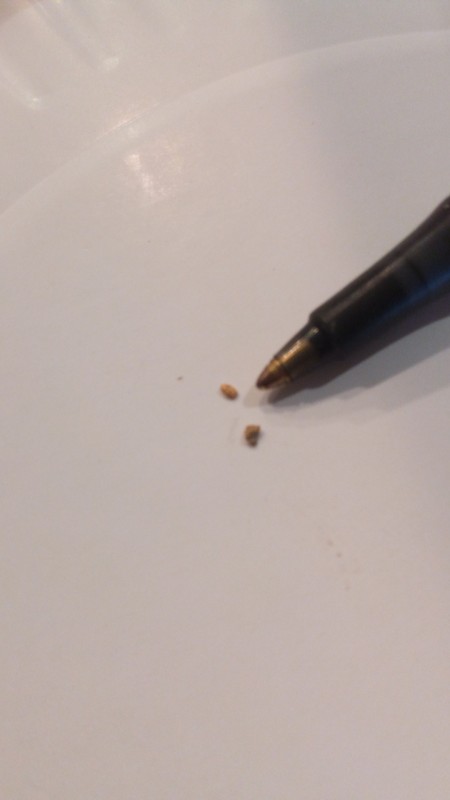
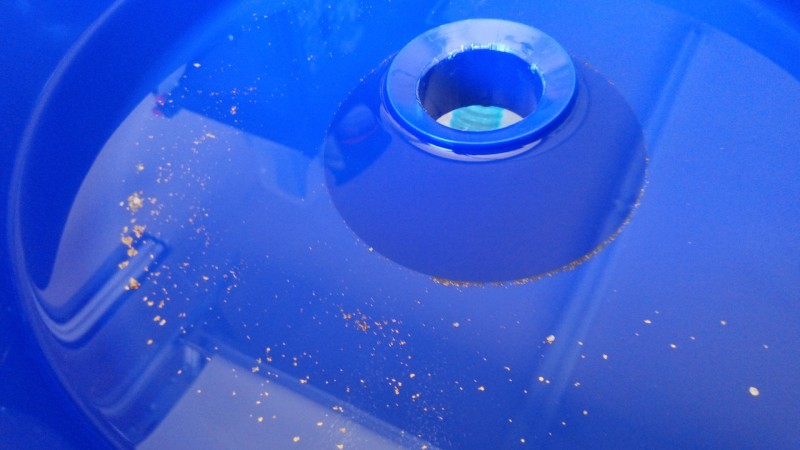
'19 Misadventures In Baja
in Detector Prospector Forum
Posted
If I only had a good Tennessee guide all things are possible.